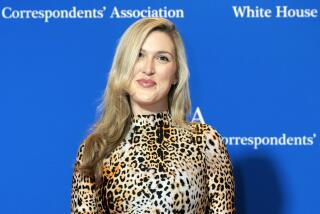Somethingâs Creepy in the May Issue of Esquire
It takes all types, including the type who thinks people can be divided into two types. For them, a well-executed bisection of humanity can leave a lasting impact.
The cover story in the May Esquire contains a walloping example of such classification.
âAt times,â Barbara Kruger begins her cover story on radio-TV wild man Howard Stern, âit seems possible to divide the world into two types of people: creeps and assholes.â
âCreeps are wound neat and tight and seldom say what they mean or mean what they say . . â Kruger writes. The others â. . . thrive on transgression, their brashness becomes both fun and predictable. Theyâll never betray you because they never say anything behind your back that they havenât already said to your face . . .â
âAha!â Esquire readers across America presumably muttered, as their world view snapped from a chaotic blur to clear focus. Then most probably plunged on into Krugerâs analysis of Stern.
But that first paragraph caused at least a few readers to prick up their ears. And a few then called writer Susin Shapiro at her New York apartment.
Had Shapiro seen the Esquire piece? It sounded, they said, a lot like a Village Voice story she wrote 14 years earlier.
Titled âCreeps and Assholes: Character Is Destiny,â Shapiroâs essay was about just that subject. She categorized humanity down to its minutiae: âCreeps suffer anorexia, migraines and allergies; (the others) break bones, and develop skin rashes.â
For elusive but disturbing reasons buried deep in the cultural subconscious, that essay marked a watershed moment for lots of readers. People put it on refrigerators; they passed photocopies around the office.
As the story gained cachet, so did Shapiro, landing a contract for a book of essays and reeling in offers from other top publications.
After a few more years of writing success, Shapiro detoured onto the mommy track. Now that daughter Samantha is in second grade, sheâs easing back into writing in a serious way.
So when she read Krugerâs Esquire story, she was steamed. After all, Shapiro wrote âCreepsâ at the Fire Island home of David Hirshey, who is now the articles editor of Esquire, she says, and it was âCreepsâ that landed her an assigment at that magazine--another provocative piece titled: âWhy I Like Men.â
Given those details, she found irony in Esquireâs unusually effusive description of Kruger as â . . . not only one of Americaâs most original talents but one of our keenest social and cultural critics as well.â
Kruger, a visual artist as well as a writer, is indisputably talented, though âoriginalâ must be applied cautiously to what she does.
Her most notorious local artwork is âUntitled (Questions),â the huge mural on the wall of MOCA at the Temporary Contemporary.
In big white letters, that mural asks: âWho is beyond the law? Who is bought and sold? Who is free to choose? Who does time? Who follows orders? Who salutes longest? Who prays longest? Who laughs last?â
The words stream across an American flag-like field of red and blue. Should Kruger have credited Jasper Johns? Betsy Ross?
Esquireâs stark red, white and black cover of Howard Stern is also her work. In that collage-type piece, the words âI hate myself--and you love me for it,â are imposed on an âalready existingâ photograph of Stern.
Still, Kruger was mortified when she learned that people connected her essay and an article she says she never heard of, let alone read.
The creep dichotomy has been âa part of the vernacular,â as long as she can remember, she says. Hirshey and Bill Tonelli, who edited the profile, agree that the idea has become public domain.
Itâs a good essay.
âFrom his jerky adolescent fantasies about women, to his constant goofing on gays and lesbians, to his deeply disturbing Fear of a Black Planet, Stern, at times, embodies the kind of dangerously unexamined populism that is so prevalent in America today,â Kruger writes.
âI worked very hard on that piece,â she says. âI pulled my hair out trying to make it as effective as possible, trying to address Howard Sternâs power and the power of the media.â
REQUIRED READING
For the American media, the presidential election is pretty much business as usual. For the worldâs press, the election, and the American mediaâs coverage of it, is a fiasco.
Hereâs a brief sampling of opinion, as excerpted in the May World Press Review:
âMuch of what is aberrant and absurd in the American political process, particularly the presidential election, can be easily traced to the baneful role that television and pollsters have come to play since 1960. Each candidate, irrespective of party label, finds himself having to submit to the joyless cycle of the need to raise funds to hire consultants, to finance endless polling in order to find out what bothers the electorate the most (including the perceived flaws in the opponents), and then to pay for television advertising aimed at exploiting the pollstersâ findings.â (The Times of India)
âThe truth is that the Americans expect too much of their Presidents: absolute integrity in a political system where multimillion-dollar personal fund raising is essential; monk-like chastity in a Permissive Age; political correctness that can be maintained only by suppressing precisely those opinions and quirks that make a politician interesting; and, furthermore, a willingness to be fiercely interrogated on all this and other issues by tin-pot media Grand Inquisitors.â (The Spectator, of London)
At least La Repubblica of Rome, offers hope: âThe media are too diverse and independent not to recover the restraint and dignity that enable them to distinguish between the boudoir and the Constitution.â
* Is a homophobic mainstream media undermining the feminist movement through a subtle and not-so-subtle âlesbian baiting?â
In this weekâs The Advocate, author Donna Minkowitz calls a variety of witnesses, most notably Gloria Steinem, who suggest that the answer is yes.
Key among the many pieces of evidence presented is a 1992 column by syndicated columnist Sally Quinn. Commenting on National Organization of Women president Jill Irelandâs declaration that she has a woman companion, Quinn wrote: âIt is impossible to read the Ireland declaration and argue that the movement she leads is still in touch with the majority of women.â
The Advocate makes a convincing case why a womanâs sexual orientation is irrelevant to her role as a feminist, or to her qualifications for any other role.
But the article also is rife with bullying overkill in support of some ill-defined party line.
âQuinn has disqualified herself from any serious consideration as a commentator about womenâs issues . . . â Steinem snaps with authoritarian finality.
As for discussion of lesbiansâ roles in the movement, a NOW spokeswoman proclaims for all womanhood: âThat debate simply doesnât exist.â
More to Read
Sign up for our Book Club newsletter
Get the latest news, events and more from the Los Angeles Times Book Club, and help us get L.A. reading and talking.
You may occasionally receive promotional content from the Los Angeles Times.









